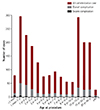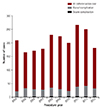1. Kim GB. Psychosocial adjustment and quality of life of adolescents and adults with congenital heart disease. Korean J Pediatr. 2014; 57:257–263.
2. Mehta R, Lee KJ, Chaturvedi R, Benson L. Complications of pediatric cardiac catheterization: a review in the current era. Catheter Cardiovasc Interv. 2008; 72:278–285.
3. Porter CJ, Gillette PC, Mullins CE, McNamara DG. Cardiac catheterization in the neonate. A comparison of three techniques. J Pediatr. 1978; 93:97–101.
4. Booth P, Redington AN, Shinebourne EA, Rigby ML. Early complications of interventional balloon catheterisation in infants and children. Br Heart J. 1991; 65:109–112.
5. Cassidy SC, Schmidt KG, Van Hare GF, Stanger P, Teitel DF. Complications of pediatric cardiac catheterization: a 3-year study. J Am Coll Cardiol. 1992; 19:1285–1293.
6. Yetman AT, Nykanen D, McCrindle BW, et al. Balloon angioplasty of recurrent coarctation: a 12-year review. J Am Coll Cardiol. 1997; 30:811–816.
7. Zeevi B, Berant M, Fogelman R, Galit BM, Blieden LC. Acute complications in the current era of therapeutic cardiac catheterization for congenital heart disease. Cardiol Young. 1999; 9:266–272.
8. Rhodes JF, Asnes JD, Blaufox AD, Sommer RJ. Impact of low body weight on frequency of pediatric cardiac catheterization complications. Am J Cardiol. 2000; 86:1275–1278.
9. Mori Y, Nakazawa M, Yagihara T. Complications of pediatric cardiac catheterization and system of catheterization laboratories minimizing complications--a Japanese multicenter survey. J Cardiol. 2010; 56:183–188.
10. West R, Ellis G, Brooks N. Joint Audit Committee of the British Cardiac Society and Royal College of Physicians of London. Complications of diagnostic cardiac catheterisation: results from a confidential inquiry into cardiac catheter complications. Heart. 2006; 92:810–814.
11. Warnes CA, Liberthson R, Danielson GK, et al. Task force 1: the changing profile of congenital heart disease in adult life. J Am Coll Cardiol. 2001; 37:1170–1175.
12. Vitiello R, McCrindle BW, Nykanen D, Freedom RM, Benson LN. Complications associated with pediatric cardiac catheterization. J Am Coll Cardiol. 1998; 32:1433–1440.
13. Brotschi B, Hug MI, Kretschmar O, Rizzi M, Albisetti M. Incidence and predictors of cardiac catheterisation-related arterial thrombosis in children. Heart. 2015; 101:948–953.
14. Krasemann T. Complications of cardiac catheterisation in children. Heart. 2015; 101:915.
15. Luceri MJ, Tala JA, Weismann CG, Silva CT, Faustino EV. Prevalence of post-thrombotic syndrome after cardiac catheterization. Pediatr Blood Cancer. 2015; 62:1222–1227.
16. Lin CH, Desai S, Nicolas R, et al. Sedation and anesthesia in pediatric and congenital cardiac catheterization: a prospective multicenter experience. Pediatr Cardiol. 2015; 36:1363–1375.
17. Bobhate P, Guo L, Jain S, et al. Cardiac catheterization in children with pulmonary hypertensive vascular disease. Pediatr Cardiol. 2015; 36:873–879.
18. Büsing KA, Schulte-Sasse C, Flüchter S, et al. Cerebral infarction: incidence and risk factors after diagnostic and interventional cardiac catheterization--prospective evaluation at diffusion-weighted MR imaging. Radiology. 2005; 235:177–183.
19. De Bono D. The Joint Audit Committee of the British Cardiac Society and Royal College of Physicians of London. Complications of diagnostic cardiac catheterisation: results from 34,041 patients in the United Kingdom confidential enquiry into cardiac catheter complications. Br Heart J. 1993; 70:297–300.
20. Glatz AC, Shah SS, McCarthy AL, et al. Prevalence of and risk factors for acute occlusive arterial injury following pediatric cardiac catheterization: a large single-center cohort study. Catheter Cardiovasc Interv. 2013; 82:454–462.
21. Stone PA, Campbell JE, AbuRahma AF. Femoral pseudoaneurysms after percutaneous access. J Vasc Surg. 2014; 60:1359–1366.
22. Zuckerman WA, Turner ME, Kerstein J, et al. Safety of cardiac catheterization at a center specializing in the care of patients with pulmonary arterial hypertension. Pulm Circ. 2013; 3:831–839.











 PDF
PDF ePub
ePub Citation
Citation Print
Print


 XML Download
XML Download